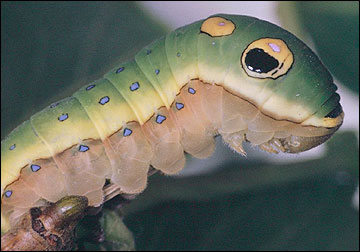Spicebush swallowtail
Swallowtails
 Spicebush swallowtail caterpillars (Papilio troilus) are present from May to October. They produce two to three generations per year.
Spicebush swallowtail caterpillars (Papilio troilus) are present from May to October. They produce two to three generations per year.
Young spicebush swallowtail caterpillars look like bird droppings (similar to the parsleyworm). Full-grown caterpillars are about 1.5 inches long with the body being swollen at the third thoracic segment. The top half of the body is green (or bright orange), which then turns into a thin area of yellow containing the spiracles, and then the bottom half of the body (including legs) is reddish tan. On the third thoracic segment there is a pair of large yellow-orange spots outlined in black. Each of these yellow spots has a large black center and a smaller light-colored spot. These eye spots give the impression of being the large “pupiled eyes” of a vertebrate. On the first abdominal segment there is another pair of smaller yellow-orange spots outlined in black. However, these spots do not have a large black center or “pupil.” The rest of the abdominal segments each have six small, conspicuous blue spots. The primary host plants are spicebush, sassafras and magnolias.
About the family
Swallowtail caterpillars of the Papilionidae family are usually smooth-bodied and vary in color from green or yellow-orange with black markings to a color pattern that gives them the appearance of a bird dropping or the head of a vertebrate with conspicuous “eyes.” All swallowtail caterpillar species possess a scent gland called an osmeterium that is located just behind the head. When disturbed, this fleshy-looking, forked, orange-red gland is everted from its pouch and releases a disagreeable odor. Because the caterpillars are relatively large and very colorful, they too (with royal and silkworm caterpillars) are quite noticeable. Very few species would be considered important pests. Many adults from this family are colorful and beautiful medium-size to large butterflies. Their name is derived from the presence of tail-like projections on the hind wings.